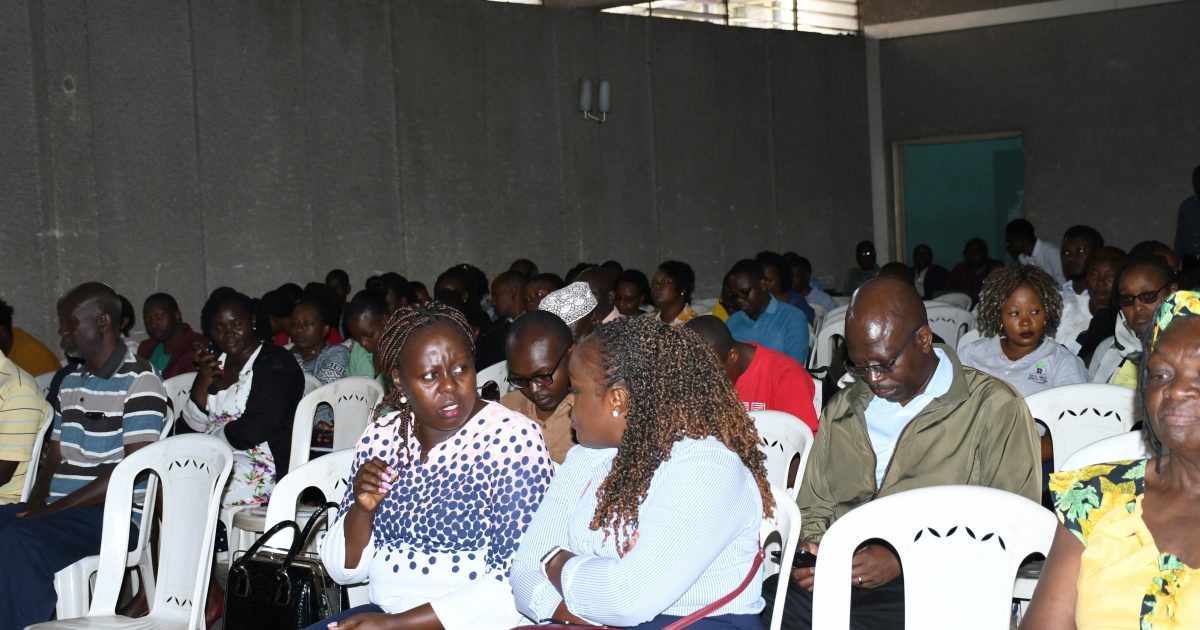The Social Health Authority (SHA) has moved to assure Kenyans that the new Social Health Insurance Fund (SHIF) would significantly lower the cost of health care for poor households in the country.
The Authority has indicated that a raft of regulations to govern SHIF would address the limitations observed in the National Hospital Insurance Fund (NHIF) by prioritizing equitable access to quality, affordable and comprehensive health care for all.
SHA Chairman Dr Timothy Olweny further disclosed that Kenyans would start contributing to SHIF next month following a court ruling that gave a green light on its implementation.
Speaking at the Rift Valley Regional Commissioner’s plenary hall in Nakuru during a public participation on draft Social Health Insurance (General) Regulations, 2023, Dr Olweny explained that besides addressing basic health services, SHIF encompasses a wide range of healthcare services, ensuring that Kenyans have access to quality healthcare across various medical needs.
NHIF has a total of 15.4 million members. Out of this, only 6.7 million are active members. In the 2021/2022 financial year, NHIF collected a total of Sh61.53 billion from its members.
The 57-year-old NHIF is set to be disbanded and replaced by the Social Health Authority thanks to the Social Health Insurance Bill of 2023.
Under the new SHIF, health benefits will be accessed in all facilities accredited by SHA, and licensed by the medical council.
“SHA will offer services in public facilities, faith-based, and private facilities. SHA will pay standardized tariffs to all hospitals, including private and public ones. People will be free to choose which facilities to access, but those looking for high-end facilities might have to top up for additional services,” said Dr Olweny.
The Court of Appeal last month lifted an order blocking the implementation of the Social Health Insurance Fund (SHIF) paving way for the government to roll out the new Universal Health Care (UHC) laws.
A bench of three judges lifted the order blocking the roll-out following an application at the court for a temporary suspension of the High Court directive pending the determination of the case filed by Joseph Enock Aura.
The Appellate Court ruling now allows the government to start the implementation of the Social Health Insurance Act, 2023, Primary Health Care Act, 2023 and Digital Health Act, 2023.
The three laws repealed the problematic NHIF and established three new funds: the Primary Healthcare Fund, the Social Health Insurance Fund and the Emergency, Chronic and Critical Illness Fund.
The SHA Chairman stated that the three new funds are strategically designed to cover various levels of healthcare services, from primary to emergency and chronic care, ensuring that no Kenyan is denied emergency medical treatment, as enshrined in Article 43(2) of the Constitution.
Dr Olweny observed that the inclusion of services such as screening, drug rehabilitation, mental health support, physiotherapy, CT scans, MRI, PET scans, X-rays, brachytherapy, outpatient and inpatient services, HIV testing, cancer screening, family planning, maternal and child clinics, surgeries, emergencies, including ambulance services, cardiac arrest, accidents, and even transplant procedures demonstrate the government’s commitment to providing holistic healthcare coverage.

“The Constitution guarantees good health to every Kenyan but most citizens have been financially drained by these ailments. High costs of treating serious medical conditions such as hypertension, cancer and diabetes necessitated development of the Fund,” noted the Chairman.
He added “All Kenyans above the age of 18 will register biometrically with the Social Health Authority (SHA) at Huduma Centres across the country, at NHIF offices that are now under SHA and at medical centres.
However, the procedure for registration will be guided by the SHA regulations, currently undergoing public participation.
Dr Olweny said the remitting of 2.75 per cent to the scheme shall commence at the point of registration.
“We plan to kick off the registration process at the beginning of March, and we are eager to retain the timelines bearing in mind there was a time which we lost because of legal cases, but we are working to ensure the registration moves fast,” he added.
Individuals in formal employment will have deductions of 2.75 per cent on their salaries done through their employer which Dr Olweny said shall be done by the ninth day of every month.
Other members of the five-member SHA board include the Secretary General of the Central Organization of Trade Union Francis Atwoli, Zakayo Gichuki and Jacinta Mutegi. Principal Secretaries for National Treasury and Health also sit on the Board.
Dr Olweny explained that a means-testing instrument would be used to gauge household income, which would be deducted at 2.75 per cent among those in the informal section, of self-income contributors.
“Means-testing instruments will be used to determine those who can pay, and to what extent, and those who cannot pay will have the premiums paid by the government,” said the SHA chairperson.
Further, he clarified that SHA premiums were lower compared to what used to be remitted to NHIF.
While indicating that individuals in self-employment would make annual contributions to the scheme, Dr Olweny explained that workers earning Sh35,000 and below would pay premiums much lower than what they were paying on NHIF.
He observed that for those individuals earning between Sh35,000 and Sh100,000, there would be a marginal increase of Sh1050 but enhanced range of benefits from SHIF.
“Previous system was very inequitable because for example, someone earning Sh100,000 was contributing 1.7 per cent of their pay, whereas that earning Sh5,000 was paying Sh500, which is five per cent, which is inequity,” he said.
Dr. Olweny explained that the reason for the new contribution structure is to have a progressive contribution structure.
The chairperson explained that an annual payment mode for those in self-employment was proposed to avoid inefficiency in access to healthcare services, more so for those in need of surgery.
He noted that in the past, individuals have been paying to NHIF to access services, and once they access services, they default, which is not sustainable.
He underscored the importance of SHA pooling of finances by having individuals consistently pay to the scheme.
SHA will audit the upfront payment made to NHIF and have the money transferred to the authority. “SHA is the custodian of all funds,” said Dr. Olweny.
He explained that the Primary Healthcare Fund would cater to services at levels 1 to 3, the Social Health Insurance Fund will cover services at levels 4 to 6, and the Emergency, Chronic and Critical Illness Fund will handle costs once social health insurance is depleted.
According to the chairperson, this tripartite structure not only fulfills constitutional mandates but also addresses the practical aspects of healthcare delivery, ensuring a seamless and comprehensive coverage system.
The Facility Improvement Financing Act, Dr Olweny pointed out, directly tackles underfunding in public health facilities, a persistent challenge that has hindered the quality of healthcare services.
“By addressing this issue head-on, the government aims to enhance the capacity and capabilities of public health facilities, providing better services to all citizens by collecting, retaining, and planning for use of revenues generated from facilities,” he noted.
The Digital Health Act, he explained, signals a leap forward in technology adoption for healthcare in Kenya.
It aims to establish and maintain a comprehensive integrated health information system that links all the major pillars of UHC, such as Health Commodity, Health Financing and Human Resources for Health.
He indicated that by leveraging on technology, the government aims to enhance data sharing and resource utilization, creating a more efficient and responsive healthcare system.
The digital transformation, Dr Olweny stated, aligns with global trends and ensures that Kenya’s healthcare infrastructure is not only robust but also capable of adapting to future challenges.
The Ministry of Health has gazetted the transition committee to oversee changes in the health scheme.
The Transition Committee on the Social Health Authority is mandated to ensure a seamless transition from the National Health Insurance Fund (NHIF) to the Social Health Authority (SHA).
Health Cabinet Secretary Ms Susan Nakhumicha appointed the ten-member committee through a gazette notice dated January 25.
The transition committee is chaired by Jason Kap-Kirwok. Members of the committee include Dr Daniel Mwai (Presidential Health Advisor and Health Economist), Dr Kipruto Chermusoi Chesang, Dr Jacinta Wasike, Gladys Wambui Mburu, Stephen Kaboro Mbugua and Dr Elizabeth Wangia. Other members are Christopher Leparan Tialal, Dr Jacob Otachi Orina and Dr Stanley Bii.
The committee is mandated to develop a legal and institutional framework for the coordinated transition to SHA.
In a radical shift under SHA, services have been standardized devoid of the amount contributed to the scheme.
For example, those paying Sh300 and those paying more than Sh1 million will be able to access equal services under SHA.
“SHA will not have a mix of schemes that are going to be run. It is one package for everyone regardless of contribution. This is the principle of SHA,” said Dr Olweny.
Furthermore, noted the chairman, the Fund will have positive implications for the workforce and productivity as a healthier population will translate into more productive workers and entrepreneurs, contributing to economic growth.
“By addressing health issues proactively, the initiative aims to reduce absenteeism and improve overall workforce efficiency. With a substantial portion of the population covered by the Fund, there is a likelihood of decreased pressure on government-funded healthcare facilities. This could result in shorter waiting times, improved service delivery, and better overall experiences for patients seeking care in public hospitals,” he observed.
As Kenya works towards the implementation of Universal Health Coverage (UHC), he explained that SHA is not in the business of providing healthcare but financing healthcare.
He said counties are therefore expected to enhance the capacity of their human resource, medical supplies and technologies to guarantee access to quality healthcare services by all Kenyans.
By Anne Mwale





